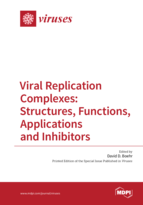Viral Replication Complexes: Structures, Functions, Applications and Inhibitors
A special issue of Viruses (ISSN 1999-4915).
Deadline for manuscript submissions: closed (30 April 2015) | Viewed by 186489
Special Issue Editor
Interests: enzymes; protein biophysics; allostery; protein engineering; NMR; microbiology
Special Issues, Collections and Topics in MDPI journals
Special Issue Information
Dear Colleagues,
Viruses are obligate intracellular parasites that need to co-opt a living cell’s machinery for replication. At the heart of the viral replication machinery are the nucleic acid polymerases, which are responsible for efficiently copying the viral genome. This process must often be coordinated with other viral processes including protein translation and viral packaging. The nucleic acid polymerases may also be responsible for generating genetic diversity that is important for escape from the host’s defenses. The polymerases and other components of the replication machinery may serve as potential anti-viral targets. In this Special Issue, we seek to highlight recent advances into uncovering the structure and function of viral replication complexes. We are especially seeking to highlight the wide-range of methodologies used to gain structural insight into viral replication. Topics of interest include molecular mechanisms of nucleic acid polymerases, nucleic acid recognition and translocation, fidelity and error correction, interactions with lipid membranes, and coordination/regulation of transcription, translation and replication processes.
Dr. David Boehr
Guest Editor
Manuscript Submission Information
Manuscripts should be submitted online at www.mdpi.com by registering and logging in to this website. Once you are registered, click here to go to the submission form. Manuscripts can be submitted until the deadline. All submissions that pass pre-check are peer-reviewed. Accepted papers will be published continuously in the journal (as soon as accepted) and will be listed together on the special issue website. Research articles, review articles as well as short communications are invited. For planned papers, a title and short abstract (about 100 words) can be sent to the Editorial Office for announcement on this website.
Submitted manuscripts should not have been published previously, nor be under consideration for publication elsewhere (except conference proceedings papers). All manuscripts are thoroughly refereed through a single-blind peer-review process. A guide for authors and other relevant information for submission of manuscripts is available on the Instructions for Authors page. Viruses is an international peer-reviewed open access monthly journal published by MDPI.
Please visit the Instructions for Authors page before submitting a manuscript. The Article Processing Charge (APC) for publication in this open access journal is 2600 CHF (Swiss Francs). Submitted papers should be well formatted and use good English. Authors may use MDPI's English editing service prior to publication or during author revisions.
Keywords
- virus
- replication
- polymerase
- fidelity
- quasi-species
- assembly
- nucleic acid
- translation
- structural biology
Related Special Issues
- Structure-Function Relationships in Viral Polymerases in Viruses (7 articles)
- Viral Replication Complexes in Viruses (12 articles)







